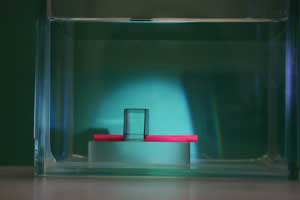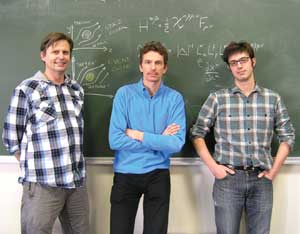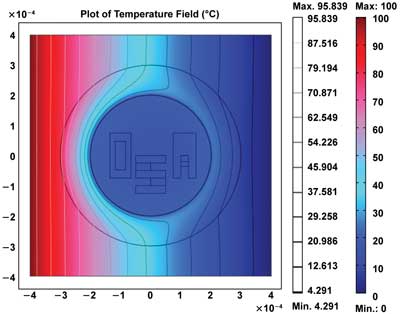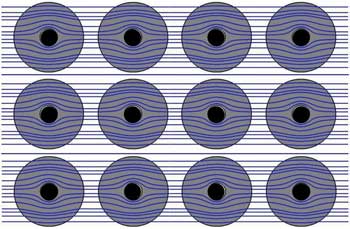But research moves toward practical applications of cloaking technology.
Invisibility cloaks have long captured our imaginations, whether actual cloaks imbued with magical powers – see the Lord of the Rings and the Harry Potter series – or the conceptually related “cloaking technology” found everywhere in science fiction and high-tech action movies.
The latter often come with a perfectly plausible, if not yet perfectly realized, explanation of how they might work. To wit: Large arrays of tiny cameras on one side of an object (or person, or Aston Martin Vanquish with a British secret agent at the wheel) project images of what is behind the object onto large arrays of tiny displays on the other side. Thus, an observer will effectively see through the thing in question.
As is so often the case, though, fact is stranger – and far more interesting – than fiction. In recent years, researchers have outlined and even demonstrated invisibility schemes using metamaterials: artificial materials whose electromagnetic and structural characteristics enable the engineering of optical properties. Thus, they have shown that they can cancel light directed at an object or guide it around the object, literally making it “disappear” to an observer.

Researchers have demonstrated an approach to invisibility that uses calcite, a common material. As with other invisibility cloaks, the approach is two-dimensional: Here, the rolled-up sticky note is visible from the side but not head-on. “Therefore, it still does not make a full Harry Potter-like cloak,” said George Barbastathis, one of the authors of the study. A host of other applications could benefit, however. Courtesy of Baile Zhang and George Barbastathis.
Now investigators are reporting other approaches to invisibility. Using a common material called calcite, for example, and taking advantage of anisotropy and directional differences in optical properties, researchers at MIT in Cambridge and the Singapore-MIT Alliance for Research and Technology (SMART) Centre have shown that, under certain conditions, they can render objects as tall as 2 mm invisible (see: “Putting More Than Glass in the Toolbox,” Photonics Spectra, January 2012, p. 78).
At about the same time, researchers from the University of Birmingham, with colleagues at Imperial College London and Technical University of Denmark, reported a calcite-based invisibility cloak that could hide an object centimeters in dimension.
Here’s the thing, though. There is a difference between making a rolled-up sticky note disappear – as in the SMART Centre study – and, say, rendering a person wholly invisible. To begin with, George Barbastathis, Singapore research professor of optics and MIT mechanical engineering professor, said recently in an email, all of the experimentally developed cloaks thus far are two-dimensional. In demonstrations of the cloak described here, the sticky note is invisible when viewing it head-on but not from the side.
Also, the scaling of the geometry indicates that cloaking a larger object such as a person would require “a rather impractically large piece of calcite.”
“We still have some way to go before these things become commonplace for children to play hide-and-seek or the military to hide tanks and airplanes,” Barbastathis said.
He believes that the value of cloaking is that, in attempting to create cloaks, we learn much about “new and clever ways” to manipulate light. For example, Baile Zhang, another researcher involved in the study, has since moved to Nanyang Technological University in Singapore, where he is pursuing a kind of waveguide-bending adapter, based on the same idea, that has demonstrably lower scattering loss than previous designs.
“To a layperson, this sounds rather esoteric or dull,” Barbastathis said, “but it can have tremendous potential impact in integrated optical devices in practice.”
This is a refrain one hears often in talking about cloaking technology. As much as we – and, it should be said, the military – would like to see true invisibility cloaks, it is not clear whether such cloaks will ever have practical use in any widespread application. That said, the concepts are valuable in and of themselves and can be applied in a variety of other ways.
Last year, Paul Kinsler, Martin McCall and Alberto Favaro of Imperial College London, along with Allan Boardman of the University of Salford, also in the UK, reported a new idea based on invisibility: the space-time “event” cloak, which adds the dimension of time. While spatial cloaks divert light around an object, thus rendering the object invisible, the space-time cloak would slow down and speed up the illuminating photons to create a dark interval where events can take place undetected.

At Imperial College London, researchers Martin McCall (left), Paul Kinsler (center) and Alberto Favaro have outlined an approach to a space-time cloak in which entire events can be hidden from view by slowing down and speeding up illuminating photons. Courtesy of Paul Kinsler.
There are many scenarios in which such a space-time cloak could be deployed – magic shows, bank heists – but again, the more likely applications do not involve humans or large objects of any sort. One possibility: signal processing. Here, the cloak could be used to create a temporary gap in a continuous data stream, and that interval could be used to process higher priority data while ensuring that no evidence of the tampering remains.
And the idea of the space-time cloak is a significant conceptual advance in itself. “So the most important ‘application’ may just be in new ways of thinking about processes, leading to new ideas for devices and applications,” Kinsler said.
Will we ever see the sort of cloaking device envisioned by the military and so long embedded in the public imagination?
“Perhaps, sadly,” he added, “the advent of invisible hover tanks remains unlikely.”
This is not to say that the military won’t benefit from invisibility cloaks – or the materials behind them. Sir John Pendry, the Imperial College London physicist who demonstrated the first practical invisibility cloak in 2006, said that, although invisibility was the application he and colleagues chose to showcase their new twin technologies – metamaterials and transformation optics – the technologies offer broad applicability beyond such cloaks.
Military camouflage, in the form of radar signature faking, is one of the likely applications. Other possibilities include satellite communications uses such as Intellectual Ventures’ metamaterials surface antenna technology – which can contribute to communications-on-the-move applications in aeronautical, maritime and land transport markets, for example – as well as terahertz sources and efficient lenses for terahertz radar.
“Oddly enough, I believe that the relatively unsophisticated applications such as the satcom receiver will be the first commercially significant ones,” Pendry said.
A hot topic, cool at the center
Researchers are beginning to look at ways in which cloaking might be applied elsewhere. For example, Sebastien Guenneau and colleagues at the University of Aix-Marseille and France’s Centre National de la Recherche Scientifique (CNRS) have described an approach to “thermal cloaking” that offers a novel means to control heat.

One possible application of invisibility cloak technology: cloaking and concentrating heat flux. This figure shows that the object in the center of the cloak (letters OSA) stays cold, while the heat diffuses elsewhere. The source of the heat is on the left-hand side and at a constant temperature of 100 °C, and the material inside the invisibility region remains cold. Courtesy of Sebastien Guenneau, Institut Fresnel, CNRS/AMU.
Just as other invisibility cloaks guide light around an object, the thermal cloak guides heat around an object – thus helping to keep the object cool. It could find application in electronics and someday even in spacecraft and solar power technologies.
Although the fundamental concepts are the same, application of those concepts required some finessing in this study because it involved diffusion and not wave propagation. “The heat equation is much different from the wave equation,” Guenneau said. “Mathematically, the former is parabolic, the latter is elliptic,” so the behind-the-scenes math needed to be revisited to get it right.
The researchers continue to develop the thermal cloaking technique. They are collaborating with Natalie Rolland’s group at the Institute of Microelectronics at the University of Lille in France and with Martin Wegener’s group at Karlsruhe Institute for Technology in Germany to manufacture and characterize working cloaks and hope to have some thermal metamaterials characterized by the end of the year.
Invisibility cloaks and the “trapped rainbow” effect
Last year, investigators with Friedrich Schiller University in Jena, Germany, suggested that arrays of invisibility cloaks could contribute to a range of applications: low-interference communication, noninvasive probing, and sensing and communication networks, among others. Now, a group at Towson (Md.) University and the University of Maryland in College Park have reported experimental realization of such an array.

A schematic drawing of light propagation through a cloak array. Researchers say arrays of invisibility cloaks could aid in low-interference communication, noninvasive probing, and sensing and communication networks. Courtesy of Vera Smolyaninova.
To achieve this, the researchers coated a commercially available microlens array with a thin film of gold and positioned it above a flat, gold-coated sheet of glass. Light directed from the side traveled around the lenses of the array, producing a cloak in the center of each. The overall effect of this was to slow down the light.
Slowed light can be put to important use. “In our opinion, the most interesting practical application of the developed technique is in large arrays of bio/chemical sensors,” said Vera Smolyaninova, lead author of the study, which was published in New Journal of Physics. She added that such arrays also might offer a more precise means to test invisibility cloaks.